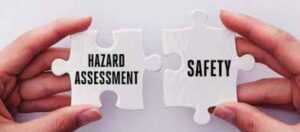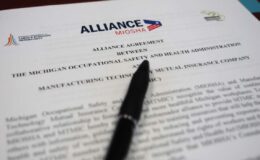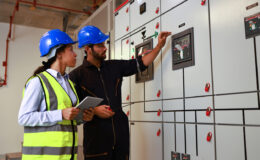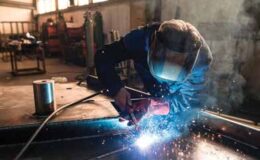By Travis Halsted, MS, CSP, ARM, COSS
Loss Control Consultant
As the weather is warming up, I am finding more and more of my visits with policyholders that result in us spending some time outside to check the perimeter of the building, parking lots, truck bays and other areas that often can go without routine inspections due to weather conditions. During one particular inspection I noticed a large area of dead poison ivy climbing the facility wall, and an impressive dormant bee nest in the tree next to their outside eating area. I asked them if they include the “outside” area in their facility hazard identification process. I was met with a response that got me thinking. That response was that they will add that aspect as soon as they start doing that inside the building first. My contact at this company felt that they weren’t qualified to identify hazards, and that by not knowing all of the standards and rules, it prevented them from being the person to do that. Sadly, as I started to ask some of my contacts at other policyholders if they felt that they were qualified to do hazard identification they said no, and that’s why they rely so heavily on their Loss Control Consultant. I want to assure all of you that you are qualified, and with some training on what to look for, you can become an expert at hazard identification as well.
In February I visited with a policyholder that has several large manufacturing plants. During this visit I conducted a training of their safety committee on how to complete a workplace hazard identification process. For this training we broke the safety committee into groups of several teams of two people each. Each team surveyed a particular area for hazards. When they found something that they thought was a hazard, they placed a sticky note on the item. When each group completed their respective area we collected as a group and walked through the area looking at each sticky note. I was thoroughly impressed at how some of the members have had little to no safety inspection training but were not only identifying health and safety infractions, but also some best practices items. After we reviewed each area, I completed my own inspection of the areas. From that I pointed out some items that may have been overlooked and we reviewed ways to breakdown identifying hazards, and what to do with them once they were identified.
This simple practice provided these employees with additional health and safety knowledge, a fun time while promoting health and safety in the workplace, and, most importantly, helped them develop a level of confidence in their ability to be a contributor to a proactive safety culture.
When doing a hazard identification of your facility, many may just identify the physical items that they are familiar with when safety is discussed. This includes guarding, cords on floors, and fall protection items, just to name a few. While these are great items to identify, there are other items, along with physical, that need to be considered when identifying hazards. Lets take a second to look at the items to be identified during a hazard identification.
- CHEMICAL HAZARDS. This item pertains to identifying chemicals that may be volatile, have low exposure limits, and how the chemicals can react with other chemicals. The use of Safety Data Sheets (SDS) will assist you in identifying the hazards that come with each chemical. When looking at the chemical label, pictograms are also a quick way to identify hazardous chemicals.
- PHYSICAL HAZARDS. Physical hazards are probably the most wide-spread form of hazard identification, and the one that can quickly prevent acute type injuries/illnesses. Items may include, but are not limited to; slip/trip/fall hazards, electrical hazards, machine guarding and other machine hazards, confined space access and control, and fall protection. While these are often easy to find, and can provide quick results, ensure that this form of identification is not your only form of hazards that you are identifying.
- BIOLOGICAL HAZARDS. Biological hazards can include items that workers could be exposed to such as infectious diseases, Hexavalent Chromium, Beryllium, Cadmium, Arsenic, Lead, Mercury, and even toxic or poisonous plants (poison ivy). When reviewing this its paramount to review the raw materials that your daily processes require. These materials could lead to Silicosis, Acute Beryllium Disease (ABD), and neurological/respiratory/cardiovascular disorders. These hazards can be identified in house, but may require an Industrial Hygienist to accurately measure the exposure of the item to the employees working with the hazard.
- ERGONOMIC HAZARDS. The ergonomic hazards can be looked at as one of the largest contributors to strains, hernias, and carpal tunnel type claims. These hazards involve heavy lifting, repetitive motions, significant vibrations, bending/twisting movements, and work that is above shoulder height. When reviewing this type of hazard, the office staff can often face just as many, if not more than the production floor staff, and should be equally assessed.
Injury/Illness/Near Miss Records. This aspect should include the review of injury claims, near miss reporting, any illnesses reported, and any potential health and safety concerns reported. In this review any skin irritation, noise complaints, unusual frequency of illnesses, and any stings from that pesky beehive should be evaluated to ensure that a long term remedy is either in place, or is being developed.
When conducting the hazard identification process, encourage your employees to think outside the box. By this I mean to simply not follow a one-size-fits-all checklist. Identify the “what ifs” and “what could” when inspecting the different hazards. Furthermore, remember that the workplace is constantly changing and that new hazards can appear. New machinery, a landscaping project, an addition to the building, and even simply adding a golf cart to the maintenance department can add new hazards. Finally, it is vital to think big picture and re-evaluate a remedied hazard. These remedied hazards may become a renewed hazard if proper maintenance isn’t completed or a tool or equipment wears.
When the hazards have been identified, the process of hazard controls is another rewarding aspect. There are several different forms of controls for these hazards ranging from elimination, substitution, and engineering, administrative and personal protective controls. Please reach out to your Loss Control Consultant if you have any questions on the different types of controls and how each of them may work with your hazard management.






